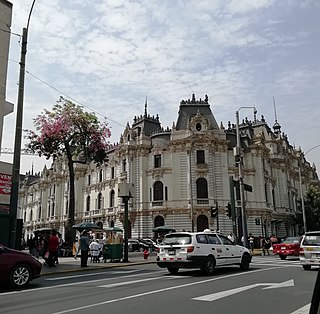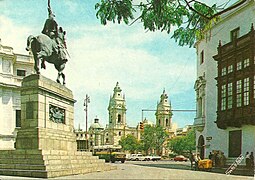
Francisco Pizarro, Marquess of the Atabillos was a Spanish conquistador, best known for his expeditions that led to the Spanish conquest of the Inca Empire.

The Basilica Cathedral of Lima, commonly known as the Metropolitan Cathedral of Lima, is a Roman Catholic cathedral in Lima, Peru. It is the seat of the Archdiocese of Lima. Its construction began in 1535 and finished in 1797, having been built in its present form between 1602 and 1797. Its patron saint is Saint John, Apostle and Evangelist, to whom it is dedicated.

The Historic Centre of Lima is the historic city centre of the city of Lima, the capital of Peru. Located in the city's districts of Lima and Rímac, both in the Rímac Valley, it consists of two areas: the first is the Monumental Zone established by the Peruvian government in 1972, and the second one—contained within the first one—is the World Heritage Site established by UNESCO in 1988, whose buildings are marked with the organisation's black-and-white shield.

The equestrian statue of Charles IV of Spain is a bronze sculpture cast by Manuel Tolsá built between 1796 and 1803 in Mexico City, Mexico in honour of King Charles IV of Spain, then the last ruler of the New Spain. This statue has been displayed in different points of the city and is considered one of the finest achievements of Mr. Tolsá. It now resides in Plaza Manuel Tolsá.

The Jirón de la Unión, or Union Street, is a pedestrian street located in the Historic Centre of Lima, part of the capital of Peru. For many decades it was the most important boulevards of the city, often described as the most aristocratic, where many of the most affluent citizens of the city and most powerful men around the world would meet. Subsequently, with the deterioration of the center of Lima, the Jirón de la Unión lost its aristocratic character and became completely commercialized.

The Plaza Mayor, also known as the Plaza de Armas, is the main public square of the historic centre of the city of Lima, Peru. It dates back to the foundation of the city by Francisco Pizarro on January 18, 1535. Delimited by Carabaya, Junín, Huallaga, and Unión streets, it is surrounded by a number of major landmarks, including the Government Palace, the Metropolitan Cathedral, the Archbishop's Palace, the Municipal Palace, and the Palacio de la Unión.
The Historic Centre of Trujillo is the main urban area and the most important center of development and unfolding in the Peruvian city of Trujillo located in La Libertad Region. The whole process of its original urban fabric is in elliptical shape surrounded by España Avenue that was built in the wake of the Wall of Trujillo. It houses the seat of city government and other important entities in the locality. In the center of this historic urban area is the Plaza de Armas of Trujillo that was the scene of the Spanish founded of the city in 1534 and the proclamation of the independence of Trujillo on December 29, 1820.

Plaza de Armas of Trujillo is the main square where the Spanish foundation of Trujillo was made, in northern Peru. It has been the principal locus of history in this city in the republic era. It is located in the central zone of the Historic Centre of Trujillo. In the streets that form this main square are located the buildings of Municipality Palace, the Cathedral, among others. The Plaza de Armas of Trujillo is formed by the Pizarro, Independencia, Orbegoso and Almagro streets. In this square, the proclamation of the independence of Trujillo took place.

Simon Bolivar, also known as General Bolivar, is a bronze equestrian statue of Simón Bolívar by Adamo Tadolini. There are three casts. The original is located in the Plaza Bolívar in Lima, the first copy is in the Plaza Bolívar in Caracas and the second copy is in United Nations Plaza in San Francisco, California.

The Plaza Bolognesi is a roundabout located in the Lima District and the Breña District, in the capital of Peru. It is located at the intersection of Brazil Avenue, Arica Avenue, Alfonso Ugarte Avenue, Guzmán Blanco Avenue, and 9 December Avenue.

The equestrian statue of Francisco Franco was an instance of public art in Madrid, Spain. The statue, depicting dictator Francisco Franco riding a horse, was removed from its location in Nuevos Ministerios and subsequently stored in March 2005.

The Monument to Manco Cápac is a statue located in the homonymous square in La Victoria District, Lima, the work of the Peruvian sculptor David Lozano, inaugurated in 1926.

The Statue of Liberty is a bronze sculpture located in the Plaza Francia of the historic centre of Lima, Peru. It was made in 1926 according to the design of the French sculptor René Bertrand-Boutée and cast by Eugène Soleau. It is a one-piece bronze sculpture about 2 metres high and represents a standing female figure, dressed in a light tunic and with a laurel wreath on her head. This is installed on a 4.30 m high pedestal. The sculpture and the Plaza Francia were declared a monumental urban environment in 1972. In 2018, La Libertad was declared Cultural Heritage of the Nation.

The Casa de Alcántara was a 16th-century building in the Historic Centre of Lima. It was demolished in 1952 and replaced by the Plaza Pizarro.

Peru Square, formerly known as Francisco Pizarro Square, is a public square located in central Lima, Peru.
The Park of the Wall is a public park located in the central district of Lima, Peru. It was inaugurated in 2004. Within its extension is part of the former Walls of Lima. The park is located between the Rímac River and the historic centre of Lima.

Ramón Castilla Square, formerly known as Union Square, is a public square in the historic centre of Lima, Peru. It is one of three squares through which Alfonso Ugarte Avenue passes—the others being Dos de Mayo and Bolognesi—and is also located at the intersection of Argentina and Emancipación avenues. It is named after former president Ramón Castilla.

The Casa del Oidor is a historical building located next to the Plaza Mayor, in the historic centre of Lima, Peru. It is best known for the large balcony that runs through its façade. It is part of the Cultural heritage of Peru.

The Fountain of the Plaza Mayor is located in the square of the same name in the historic centre of Lima, Peru. Originally inaugurated in 1578, it has since been retouched and serves as the square's main feature, itself featuring a statue of Pheme, one of the gods of Ancient Greece.

Pasaje Santa Rosa is a pedestrian alleyway located in the Damero de Pizarro, next to the Plaza Mayor of Lima, Peru. Part of the city's historic centre, it separates the City Hall from the Club de la Unión, connecting Camaná and Union streets. It also connects with the Jirón Conde de Superunda through the Pasaje Nicolás de Ribera.























